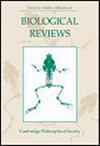From arctic lemmings to adaptive dynamics: Charles Elton's legacy in population ecology.
Biological reviews of the Cambridge Philosophical Society
Pub Date : 2007-01-11
DOI:10.1017/S1464793100005637
引用次数: 80
Abstract
We shall examine the impact of Charles S. Elton's 1924 article on periodic fluctuations in animal populations on the development of modern population ecology. We argue that his impact has been substantial and that during the past 75 years of research on multi-annual periodic fluctuations in numbers of voles, lemmings, hares, lynx and game animals he has contributed much to the contemporary understanding of the causes and consequences of population regulation. Elton was convinced that the cause of the regular fluctuations was climatic variation. To support this conclusion, he examined long-term population data then available. Despite his firm belief in a climatic cause of the self-repeating periodic dynamics which many species display, Elton was insightful and far-sighted enough to outline many of the other hypotheses since put forward as an explanation for the enigmatic long-term dynamics of some animal populations. An interesting, but largely neglected aspect in Elton's paper is that it ends with speculation regarding the evolutionary consequences of periodic population fluctuations. The modern understanding of these issues will also be scrutinised here. In population ecology, Elton's 1924 paper has spawned a whole industry of research on populations displaying multi-annual periodicity. Despite the efforts of numerous research teams and individuals focusing on the origins of multi-annual population cycles, and despite the early availability of different explanatory hypotheses, we are still lacking rigorous tests of some of these hypotheses and, consequently, a consensus of the causes of periodic fluctuations in animal populations. Although Elton would have been happy to see so much effort spent on cyclic populations, we also argue that it is unfortunate if this focus on a special case of population dynamics should distract our attention from more general problems in population and community dynamics.从北极旅鼠到适应动力学:查尔斯·埃尔顿在种群生态学中的遗产。
我们将考察查尔斯·s·埃尔顿1924年关于动物种群周期性波动的文章对现代种群生态学发展的影响。我们认为,他的影响是巨大的,在过去75年对田鼠、旅鼠、野兔、猞猁和狩猎动物数量的多年周期性波动的研究中,他对当代对种群调节的原因和后果的理解做出了很大贡献。埃尔顿确信,周期性波动的原因是气候变化。为了支持这一结论,他研究了当时可获得的长期人口数据。尽管埃尔顿坚信气候是导致许多物种表现出自我重复的周期性动态的原因,但他还是有足够的洞察力和远见,概述了许多其他假说,作为对一些动物种群神秘的长期动态的解释。在埃尔顿的论文中,一个有趣的,但在很大程度上被忽视的方面是,它以关于周期性人口波动的进化后果的猜测结束。对这些问题的现代理解也将在这里仔细审查。在种群生态学中,Elton在1924年发表的论文催生了一个研究具有多年周期性的种群的整个行业。尽管许多研究小组和个人致力于多年种群周期的起源,尽管早期有不同的解释性假设,但我们仍然缺乏对其中一些假设的严格检验,因此,对动物种群周期性波动的原因缺乏共识。虽然埃尔顿会很高兴看到如此多的精力花在循环种群上,但我们也认为,如果这种对种群动态的特殊情况的关注分散了我们对种群和社区动态中更普遍问题的注意力,那是不幸的。
本文章由计算机程序翻译,如有差异,请以英文原文为准。
求助全文
约1分钟内获得全文
求助全文

 求助内容:
求助内容: 应助结果提醒方式:
应助结果提醒方式:


